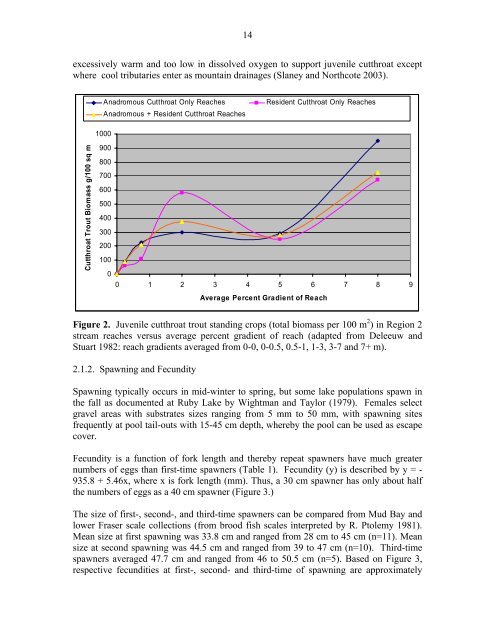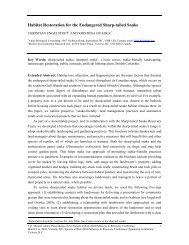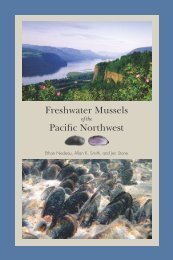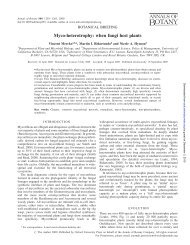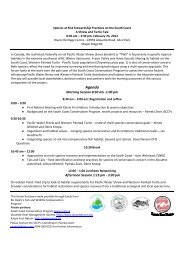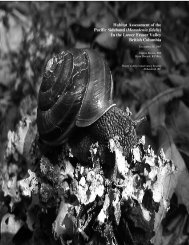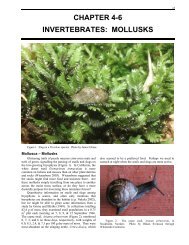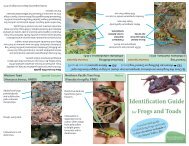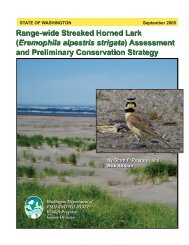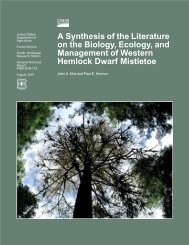14excessively warm and too low in dissolved oxygen to support juvenile cutthroat exceptwhere cool tributaries enter <strong>as</strong> mountain drainages (Slaney and Northcote 2003).Anadromous <strong>Cutthroat</strong> Only ReachesAnadromous + Resident <strong>Cutthroat</strong> ReachesResident <strong>Cutthroat</strong> Only Reaches1000<strong>Cutthroat</strong> <strong>Trout</strong> Biom<strong>as</strong>s g/100 sq m90080070060050040030020010000 1 2 3 4 5 6 7 89Average Percent Gradient <strong>of</strong> ReachFigure 2. Juvenile cutthroat trout standing crops (total biom<strong>as</strong>s per 100 m 2 ) in Region 2stream reaches versus average percent gradient <strong>of</strong> reach (adapted from Deleeuw andStuart 1982: reach gradients averaged from 0-0, 0-0.5, 0.5-1, 1-3, 3-7 and 7+ m).2.1.2. Spawning and FecunditySpawning typically occurs in mid-winter to spring, but some lake populations spawn inthe fall <strong>as</strong> documented at Ruby Lake by Wightman and Taylor (1979). Females selectgravel are<strong>as</strong> with substrates sizes ranging from 5 mm to 50 mm, with spawning sitesfrequently at pool tail-outs with 15-45 cm depth, whereby the pool can be used <strong>as</strong> escapecover.Fecundity is a function <strong>of</strong> fork length and thereby repeat spawners have much greaternumbers <strong>of</strong> eggs than first-time spawners (Table 1). Fecundity (y) is described by y = -935.8 + 5.46x, where x is fork length (mm). Thus, a 30 cm spawner h<strong>as</strong> only about halfthe numbers <strong>of</strong> eggs <strong>as</strong> a 40 cm spawner (Figure 3.)The size <strong>of</strong> first-, second-, and third-time spawners can be compared from Mud Bay andlower Fr<strong>as</strong>er scale collections (from brood fish scales interpreted by R. Ptolemy 1981).Mean size at first spawning w<strong>as</strong> 33.8 cm and ranged from 28 cm to 45 cm (n=11). Meansize at second spawning w<strong>as</strong> 44.5 cm and ranged from 39 to 47 cm (n=10). Third-timespawners averaged 47.7 cm and ranged from 46 to 50.5 cm (n=5). B<strong>as</strong>ed on Figure 3,respective fecundities at first-, second- and third-time <strong>of</strong> spawning are approximately
151,000, 1,700 and 1,900. B<strong>as</strong>ed on Table 1 and cutthroat fecundities in the <strong>Lower</strong><strong>Mainland</strong>, fisheries managers have the option, through careful selection <strong>of</strong> a minimumfish size regulation, to ensure that significant repeat spawners escape the fishery (Trotter1997). Accordingly, among conservation me<strong>as</strong>ures, the incidence <strong>of</strong> repeat spawners inthe creel should be an effective first-line indicator <strong>of</strong> excessive harvest rates.Table 1. Fecundity <strong>of</strong> first-time, second-time and third-time sea-run cutthroat troutspawners in the Pacific Northwest (compiled from data from Oregon, W<strong>as</strong>hington,British Columbia and Al<strong>as</strong>ka; from Johnston 1979)Spawning Mean No. Eggs per Female RangeFirst-time 700 250-1200Second-time 1100 900-1300Third-time 1200 1110-1400________________________________________________________________________B<strong>as</strong>ed on brood stock capture, the provincial Fr<strong>as</strong>er Valley <strong>Trout</strong> Hatchery maintains acomplete record <strong>of</strong> fecundities. From river-run/sea-run brood stock collections in the<strong>Lower</strong> Fr<strong>as</strong>er and its tributaries from 1985 to 1990, mean fecundity w<strong>as</strong> 1,019 eggs(standard deviation, 138). The mean fecundity <strong>of</strong> collected sea-run brood fish w<strong>as</strong> 960eggs (standard deviation, 170) from the Mud Bay/Crescent Beach streams from 1985 to1996. Timing <strong>of</strong> egg development in degree days (F) is slightly less in co<strong>as</strong>tal cutthroattrout than rainbow trout: 362-500 degree days to hatch plus another 100-350 degree daysto fry emergence, which typically takes place in mid-April over much <strong>of</strong> the range.2.1.3. Juvenile Rearing Habitat and Freshwater Limiting FactorsAs emph<strong>as</strong>ized by Costello and Rubidge (2004), potential egg deposition can in itselfbecome a limitation, particularly where small drainages are <strong>as</strong>sociated with intensive landdevelopment uses/activities, particularly urbanization which greatly affects hydrologicprocesses, including peak flood flows and sedimentation. An incre<strong>as</strong>ed frequency <strong>of</strong> latewinter to spring freshets can readily scour and dislodge eggs deposited in pool-tails, and/or incre<strong>as</strong>e sediment loads which incre<strong>as</strong>e sediment deposition in redd locations.Fry emergence can occur <strong>as</strong> early <strong>as</strong> March and <strong>as</strong> late <strong>as</strong> June, depending on timing <strong>of</strong>spawning and water temperatures (Trotter 1997). Then, newly emergent fry inhabitlateral low velocity microhabitats in nursery streams, and over time gradually move outinto microhabitats with greater depths and velocities which are more <strong>as</strong>sociated withcover. By autumn, fry are photo-negative <strong>as</strong> in other trout species. Territorial behaviordevelops soon after emergence <strong>as</strong> fry begin to compete for small prey items particularlyearly instars <strong>of</strong> chironimid larvae (Slaney and Northcote 1974; Glova 1984). As inrainbow trout, underyearling cutthroat prefer riffles. However, fry have been reported to


